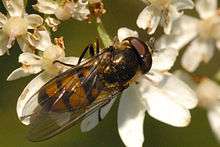Xanthandrus comtus
| Xanthandrus comtus | |
|---|---|
 | |
| Scientific classification | |
| Kingdom: | Animalia |
| Phylum: | Arthropoda |
| Class: | Insecta |
| Order: | Diptera |
| Family: | Syrphidae |
| Genus: | Xanthandrus |
| Species: | X. comtus |
| Binomial name | |
| Xanthandrus comtus (Harris, 1780) | |
| Synonyms | |
Xanthandrus comtus is a species of hoverfly. It is found in the Palearctic.[1][2]
Description
External images
For terms see Morphology of Diptera
Wing length
Wide abdomen with yellow marks.Thoracic dorsum polished black.Male with round marks on tergite 2 and confluent marks on tergites 3 and 4 (as a deeply incised band).Female with oval marks on tergite 2 and square marks on tergites 3 and 4.legs mainly orange.Antenne orange. Long black pterostigma.The male genitalia and larva are figured by Dusek and Laska (1967)..[3]
See references for determination.[4] [5] [6] [7]
.jpg)
Distribution
Palearctic Southern Norway South to Iberia.Ireland East through Central Europe and Southern Europe to Russia and the Caucasus and on to the Russian Far East and the Pacific coast; Japan; Formosa. [8] [9]
Biology
Habitat:Fagus, Quercus and Pinus forest and scrub.[10] Flowers visited include umbellifers, Arbutus unedo, Filipendula, Juncus, Leontodon, Lonicera, Mentha aquatica, Rosa, Rubus, Succisa.[11]
The larvae predate aphids and the caterpillars of various small moths including Tortricidae both on trees and low-growing plants. They are also predators of the caterpillars of the pine processionary moths Thaumetopoea pinivora and Thaumetopoea pityocampa.
References
- ↑ Stubbs, Alan E.; Falk, Steven J (1983). British Hoverflies: An Illustrated Identification Guide (2nd ed.). London: British Entomological and Natural History Society. pp. 253, xvpp. ISBN 1-899935-03-7.
- ↑ Ball, S.G.; Morris, R.K.A. (2000). Provisional atlas of British hoverflies (Diptera, Syrphidae). Monks Wood, UK: Biological Record Centre. pp. 167 pages. ISBN 1-870393-54-6.
- ↑ Dusek, J. & Laska, P. (1967) Versuch zum aufbau eines Naturlichen Systems mitteleuropaischer Arten der Unterfamilie Syrphinae (Diptera). Acta sc.nat.Brno, 1: 349-390.
- ↑ Van Veen, M. (2004) Hoverflies of Northwest Europe: identification keys to the Syrphidae. 256pp. KNNV Publishing, Utrecht.addendum
- ↑ Van der Goot,V.S. (1981) De zweefvliegen van Noordwest - Europa en Europees Rusland, in het bijzonder van de Benelux. KNNV, Uitgave no.32: 275pp. Amsterdam.
- ↑ Bei-Bienko, G.Y. & Steyskal, G.C. (1988) Keys to the Insects of the European Part of the USSR, Volume V: Diptera and Siphonaptera, Part I. Amerind Publishing Co., New Delhi. ISBN 81-205-0080-6.
- ↑ Coe, R.L. (1953) Diptera: Syrphidae. Handbks.ident.Br.insects, 10(1): 1-98. R.ent.Soc.London. pdf
- ↑ Fauna Europaea
- ↑ Peck, L.V. (1988) Syrphidae. In: Soos, A. & Papp, L. (eds.) Catalogue of Palaearctic Diptera, 8: 11-230. Akad.Kiado, Budapest.
- ↑ Speight, M.C.D. (2011). "Species accounts of European Syrphidae (Diptera)" (PDF). Syrph the Net, the database of European Syrphidae. 65: 285pp.
- ↑ de Buck, N. (1990) Bloembezoek en bestuivingsecologie van Zweefvliegen (Diptera, Syrphidae) in het bijzonder voor België. Doc.Trav. IRSNB, no.60, 1-167.